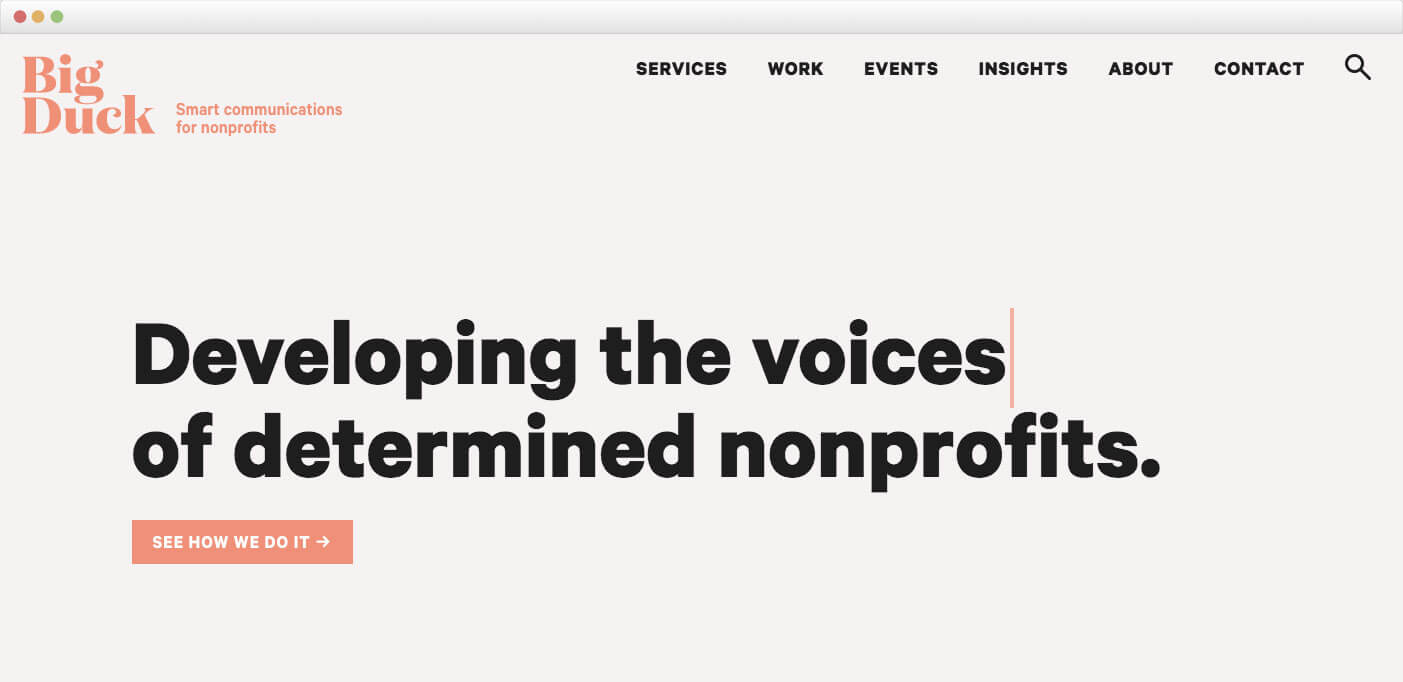Do you need a tagline—or something else?
I’ve worked on a lot of tagline assignments over my 12.5 years at Big Duck. Add another 12.5 years of professional experience, and you’ve got a quarter of a century of observing, studying, and creating taglines. It’s an honest day’s work. (Listen to our podcast about nonprofit taglines here.)
Over that time, I’ve noticed that taglines go through cycles of importance—they’re necessary, then they’re optional, then they’re disposable, then back to necessary.
I feel like we’re going through another phase of taglines falling out of favor. I’ve no real research to back this up—it’s purely observational. It just seems that more organizations are willing to go without a tagline, which is both understandable and unfortunate. What I suggest is that we start thinking a bit differently about taglines.
For years now we’ve been pushing our clients to focus on more than their logo with their visual identities. The logo lives within a visual system. In fact, the visual system itself is probably more important to the brand than the logo itself.
Why not think about taglines this way? After all, your tagline lives within a messaging platform. The messaging and visual systems (or verbal and visual identities, if you prefer) work together to become the creative assets of your brand. (We also hope all of this work comes out of a brand strategy, of course!)
Your messaging includes your name and tagline; your vision, mission, and values statements; your key messages, boilerplate, and elevator pitch. You might also roll out various campaigns, cases for giving, manifestos, and more that incorporate new themes and language that can all be codified into your messaging platform.
In developing all of these different pieces of your messaging platform, you’re going to find words or phrases that resonate deeply to you or your audiences. One of these particularly short, pithy phrases might become your official tagline. Other phrases might become part of your visual system.
Let me use Big Duck as an example of what I mean exactly.
Big Duck’s tagline is now, and has been for nearly 20 years, “smart communications for nonprofits.” As a company with a name that says nothing about what we do, we need a tagline to do some explaining. This short phrase does that useful work.
When we were updating our brand and website a couple of years ago, we revisited some of our messaging, and you can see some of the phrases that rose to the top for us.

On the homepage, the first thing your eye notices is the big text in the middle of the screen: “Developing the [voices/campaigns/teams] of determined nonprofits.” It’s a phrase we hope will draw in our audiences. And it’s part of our identity system. (Our logo and tagline are still there in the upper left corner.)
The About page on our website begins with “We believe.” Within that manifesto (for lack of a better term) there’s quite a bit of language we could pull out and highlight—i.e., use as part of our identity system—depending on what we need it for. A banner at a conference could read, “When you embrace smart communications, you are unstoppable.” A brochure could feature, “Turn to us during moments of growth and change.”
As taglines, these phrases don’t really work for us for various reasons. But as part of our visual system used in specific settings for specific audiences, they’re effective.
It’s easy for me to imagine a day when Big Duck gets rid of its tagline altogether and relies on a series of phrases from the messaging platform that gets codified as part of the visual system. It’s certainly more flexible.
So why NOT do it? Well, the primary reason is practical. Having a tagline that’s “locked up” with your logo is a whole lot simpler. You just drop that artwork on whatever you’re working on. It’s “plug-and-play.”
On the other hand, a flexible brand requires more maintenance. The more flexible a brand is, the more work it is. You need to ask yourself whether you have the ability—either through on-staff resources or perhaps with a freelancer—to maintain a brand that requires constant upkeep.
Perhaps it’s all part of a larger trend or cycle, but it looks to me like brands are getting more flexible generally, and this is affecting the thinking around taglines as well.
Maybe we don’t have just one tagline anymore. Maybe we have a collection of phrases and sentences that we can use creatively and flexibly as part of our overall brand experience.




